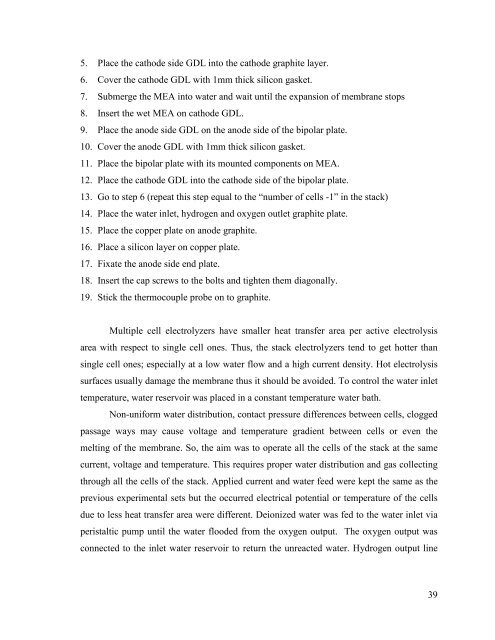hydrogen production from water using solar cells powered nafion ...
hydrogen production from water using solar cells powered nafion ...
hydrogen production from water using solar cells powered nafion ...
You also want an ePaper? Increase the reach of your titles
YUMPU automatically turns print PDFs into web optimized ePapers that Google loves.
5. Place the cathode side GDL into the cathode graphite layer.<br />
6. Cover the cathode GDL with 1mm thick silicon gasket.<br />
7. Submerge the MEA into <strong>water</strong> and wait until the expansion of membrane stops<br />
8. Insert the wet MEA on cathode GDL.<br />
9. Place the anode side GDL on the anode side of the bipolar plate.<br />
10. Cover the anode GDL with 1mm thick silicon gasket.<br />
11. Place the bipolar plate with its mounted components on MEA.<br />
12. Place the cathode GDL into the cathode side of the bipolar plate.<br />
13. Go to step 6 (repeat this step equal to the “number of <strong>cells</strong> -1” in the stack)<br />
14. Place the <strong>water</strong> inlet, <strong>hydrogen</strong> and oxygen outlet graphite plate.<br />
15. Place the copper plate on anode graphite.<br />
16. Place a silicon layer on copper plate.<br />
17. Fixate the anode side end plate.<br />
18. Insert the cap screws to the bolts and tighten them diagonally.<br />
19. Stick the thermocouple probe on to graphite.<br />
Multiple cell electrolyzers have smaller heat transfer area per active electrolysis<br />
area with respect to single cell ones. Thus, the stack electrolyzers tend to get hotter than<br />
single cell ones; especially at a low <strong>water</strong> flow and a high current density. Hot electrolysis<br />
surfaces usually damage the membrane thus it should be avoided. To control the <strong>water</strong> inlet<br />
temperature, <strong>water</strong> reservoir was placed in a constant temperature <strong>water</strong> bath.<br />
Non-uniform <strong>water</strong> distribution, contact pressure differences between <strong>cells</strong>, clogged<br />
passage ways may cause voltage and temperature gradient between <strong>cells</strong> or even the<br />
melting of the membrane. So, the aim was to operate all the <strong>cells</strong> of the stack at the same<br />
current, voltage and temperature. This requires proper <strong>water</strong> distribution and gas collecting<br />
through all the <strong>cells</strong> of the stack. Applied current and <strong>water</strong> feed were kept the same as the<br />
previous experimental sets but the occurred electrical potential or temperature of the <strong>cells</strong><br />
due to less heat transfer area were different. Deionized <strong>water</strong> was fed to the <strong>water</strong> inlet via<br />
peristaltic pump until the <strong>water</strong> flooded <strong>from</strong> the oxygen output. The oxygen output was<br />
connected to the inlet <strong>water</strong> reservoir to return the unreacted <strong>water</strong>. Hydrogen output line<br />
39

















